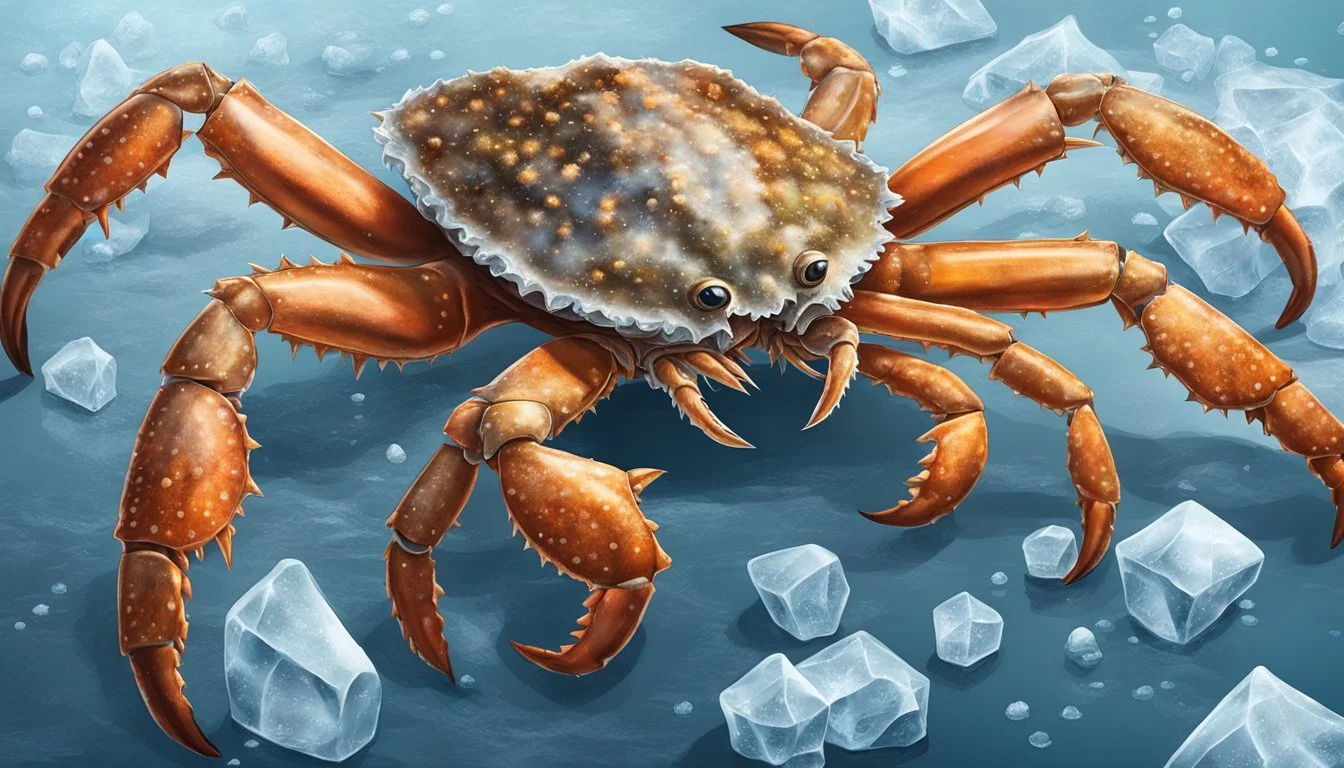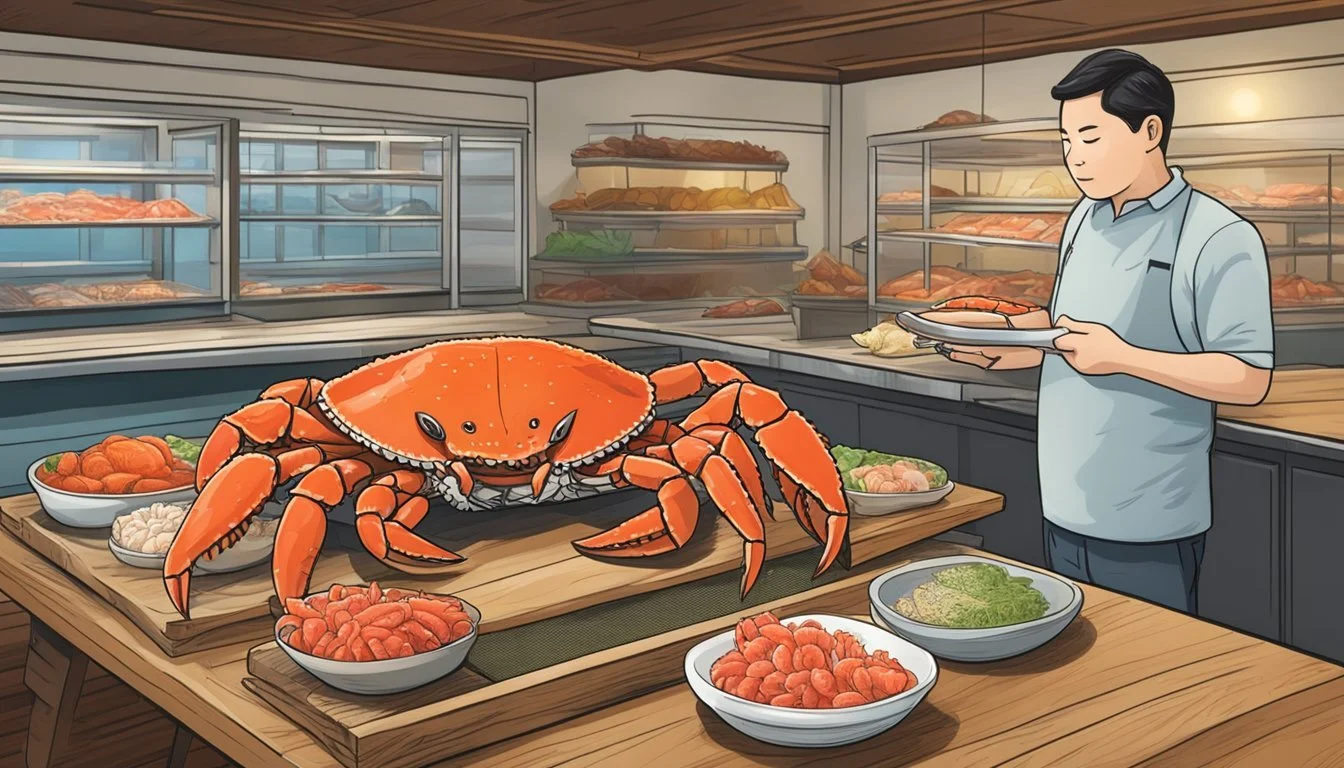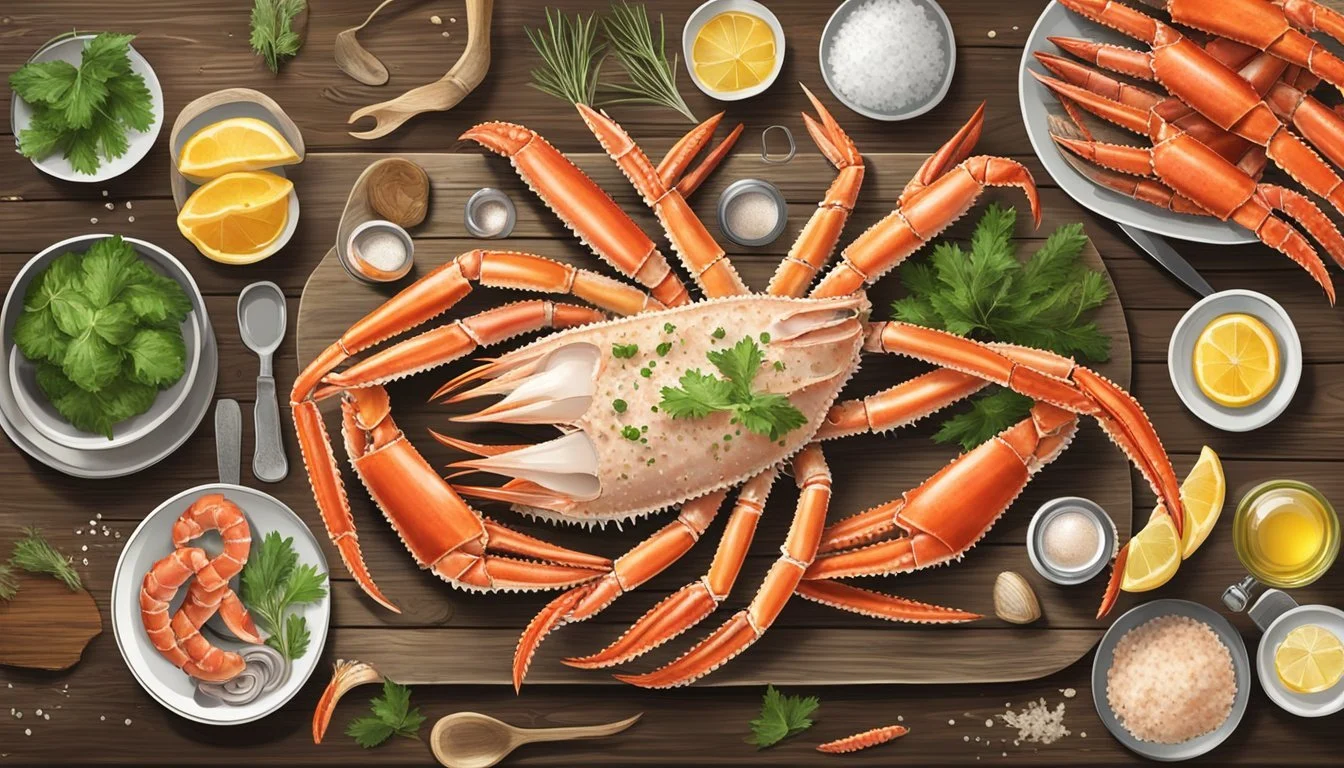Fresh vs Frozen King Crab: Comparing Taste, Texture, and Culinary Quality
King crab, with its succulent meat and impressive size, reigns supreme in the world of seafood delicacies. When it comes to enjoying this prized crustacean, consumers often face a choice between fresh and frozen options. Both fresh and frozen king crab can provide excellent flavor and quality, with the main differences lying in convenience, availability, and sometimes price.
Fresh king crab offers unparalleled taste and texture, often considered the pinnacle of crab dining experiences. It's typically available in coastal areas or high-end seafood restaurants. Frozen king crab, on the other hand, brings convenience and wider accessibility to inland regions and home kitchens. Modern freezing techniques have significantly improved, preserving much of the crab's original flavor and texture.
The decision between fresh and frozen king crab ultimately depends on personal preferences, location, and intended use. Fresh crab shines in simple preparations where its delicate flavors can take center stage. Frozen crab performs well in various recipes and offers flexibility in meal planning. Regardless of the choice, proper handling and cooking techniques are crucial to fully enjoy the regal taste of king crab.
Understanding King Crab
King crabs are renowned for their large size, delicious meat, and high market value. They are a prized catch for commercial fisheries and seafood enthusiasts alike.
Species and Types
King crabs encompass several species, with the red king crab being the most well-known. Other types include blue king crab and golden king crab. Red king crabs are the largest, often weighing up to 20 pounds with a leg span reaching 5 feet.
Blue king crabs are slightly smaller but still impressive in size. They have a distinctive bluish-purple shell color. Golden king crabs are the smallest of the three, typically found in deeper waters.
Each species has unique characteristics and habitat preferences. Red king crabs prefer colder waters and are commonly found in the Bering Sea and Gulf of Alaska.
Anatomy of King Crab
King crabs have a distinctive appearance with a large, spiny carapace and long, powerful legs. Their body is divided into two main sections: the cephalothorax (head and thorax combined) and the abdomen.
The most prized part of a king crab is its legs, which contain succulent, sweet meat. A typical king crab has three pairs of walking legs and one pair of claws.
King crabs have a hard exoskeleton that they shed periodically to grow. This process, called molting, leaves them vulnerable until their new shell hardens.
Their eyes are on stalks, providing a wide field of vision. They use their antennae for sensing their environment and detecting food.
Fishing and Harvesting
King crab fishing is a challenging and dangerous profession, often featured in popular media. The primary fishing grounds are in the Bering Sea off the coast of Alaska.
The fishing season is strictly regulated to maintain sustainable populations. Fishermen use large pots or traps baited with fish to catch king crabs.
Once caught, live crabs are kept in seawater tanks on the fishing boats. Speed is crucial in processing to maintain quality.
Only male crabs of a certain size are legally harvested. Females and undersized males are returned to the sea to ensure population growth.
King crabs are typically sold as legs or clusters. The meat is extracted and can be sold fresh or frozen, with both options retaining the crab's sweet flavor.
Fresh King Crab
Fresh king crab offers unparalleled flavor and texture straight from the ocean. Its natural sweetness and delicate meat make it a prized delicacy for seafood enthusiasts.
Advantages of Freshness
Fresh king crab boasts superior taste and texture compared to frozen alternatives. The meat remains tender and succulent, retaining its natural juices and flavor profile. When cooked properly, fresh crab exhibits a sweet, briny taste that perfectly captures the essence of the sea.
The texture is notably firm yet delicate, allowing diners to appreciate the crab's natural qualities. Fresh crab also tends to have a brighter appearance and more vibrant color, enhancing its visual appeal on the plate.
Another benefit is the ability to select live crabs, ensuring optimal freshness and quality. This allows for greater control over the cooking process and final presentation.
Storing and Handling
Proper storage and handling are crucial for maintaining the quality of fresh king crab. Ideally, live crabs should be cooked the same day they're purchased. If necessary, they can be stored in the refrigerator for up to 24 hours.
To store:
Keep crabs alive in a moist environment
Use a damp cloth or seaweed to cover them
Store at 40°F (4°C) or below
When handling fresh crab:
Wear gloves to protect hands from sharp shells
Clean and sanitize all surfaces after contact
Cook live crabs within 24 hours of purchase
For cooked crab meat, refrigerate immediately and consume within 2-3 days. Proper storage ensures the crab maintains its delicious flavor and safe-to-eat status.
Frozen King Crab
Frozen king crab offers convenience and extended shelf life while preserving much of the crab's flavor and texture. Proper freezing and thawing techniques are crucial for maintaining quality.
Freezing Processes
Commercial king crab is typically flash frozen shortly after being caught and processed. This rapid freezing helps preserve the meat's texture and flavor by forming smaller ice crystals. Most frozen king crab is pre-cooked before freezing to lock in freshness and make preparation easier for consumers.
Vacuum-sealing helps prevent freezer burn and protects the crab from absorbing other flavors. Properly frozen king crab can maintain good quality for 4-6 months in a home freezer set at 0°F (-18°C) or below.
Thawing Techniques
The best method for thawing frozen king crab is in the refrigerator. Place the frozen crab in a colander or on a tray and allow it to thaw slowly for 8-12 hours or overnight. This gentle thawing helps maintain texture and flavor.
For faster thawing, place the sealed package in cold water, changing the water every 30 minutes. Avoid using hot water or microwaving, as this can partially cook the crab and lead to uneven texture.
Once thawed, king crab should be consumed within 1-2 days for optimal freshness. Refreezing is not recommended as it can degrade quality and increase the risk of foodborne illness.
Cooking and Preparation
Proper cooking techniques are crucial for maximizing the flavor and texture of king crab, whether fresh or frozen. Different methods suit various preferences and situations.
Pre-Cooked vs. Raw Crab
Pre-cooked king crab offers convenience and quick preparation. It's already fully cooked and only needs reheating. This option is ideal for those short on time or less experienced with seafood preparation.
Raw king crab requires full cooking but allows more control over the final taste and texture. It's preferred by many seafood enthusiasts and chefs for its fresher flavor.
Cooking times differ significantly between pre-cooked and raw crab. Pre-cooked crab needs just 5-7 minutes of reheating, while raw crab typically requires 10-15 minutes of cooking time.
Recommended Cooking Methods
Boiling is a popular and straightforward method. Fill a large pot with water, add salt, and bring to a boil. Cook thawed crab legs for 7-8 minutes or frozen legs for 9-11 minutes.
Steaming produces moist, tender meat. Place crab legs in a steamer basket over boiling water. Cover and steam for 6-10 minutes.
Grilling imparts a smoky flavor. Brush crab legs with butter or oil, grill for about 5 minutes per side.
Baking is suitable for larger quantities. Preheat oven to 350°F (175°C), brush crab legs with butter, and bake for 10-12 minutes.
Avoiding Common Mistakes
Overcooking is the most frequent error, resulting in tough, rubbery meat. Always stick to recommended cooking times and check for doneness.
Undercooking can be a food safety risk, especially with raw crab. Ensure the internal temperature reaches 145°F (63°C).
Forgetting to thaw frozen crab before cooking can lead to uneven heating. Thaw in the refrigerator overnight for best results.
Using too little water when boiling or steaming can result in uneven cooking. Ensure crab legs are fully submerged or have enough space in the steamer.
Neglecting to season the cooking water reduces flavor. Add salt, lemon, or herbs to enhance taste.
Serving and Enjoyment
King crab offers a delectable dining experience with its sweet, succulent meat. Proper serving techniques and thoughtful pairings enhance the natural flavors of this prized seafood.
Pairing and Enhancements
King crab pairs well with classic accompaniments that complement its delicate taste. Drawn butter is a traditional favorite, providing richness without overpowering the crab's natural sweetness. Fresh lemon wedges offer a bright, citrusy contrast that cuts through the richness.
For those seeking additional flavors, garlic butter or herb-infused oils make excellent dipping options. Light white wines or champagne enhance the crab's subtle notes. Crisp, chilled beers also provide a refreshing counterpoint to the rich meat.
Vegetable sides like asparagus, roasted corn, or a simple green salad balance the meal. Crusty bread helps soak up any remaining butter or juices.
Presentation Tips
Serving king crab legs whole creates an impressive visual display. Arrange the bright red legs on a large platter, garnished with lemon wedges and fresh herbs like parsley or dill.
Pre-cracking the shells slightly eases eating without compromising the dramatic presentation. Provide crab crackers, picks, and wet towels for a mess-free dining experience.
For a more casual approach, remove the meat from the shells and serve in a seafood boil with corn, potatoes, and sausage. This communal style is perfect for summer gatherings.
Warm the crab gently to preserve its tender texture. Overheating can lead to tough, stringy meat. Serve immediately after warming for the best taste and texture.
Health and Safety
King crab offers nutritional benefits and requires proper handling for safe consumption. Fresh and frozen varieties have similar nutritional profiles, but safe storage and preparation practices differ.
Nutritional Value
King crab is a nutrient-dense food rich in protein, vitamins, and minerals. A 3-ounce serving provides about 16 grams of protein, making it an excellent source of this essential macronutrient. It's low in saturated fat and calories, with only about 82 calories per serving.
King crab contains high levels of vitamin B12, crucial for nerve function and red blood cell formation. It's also a good source of zinc, which supports immune function and wound healing.
Both fresh and frozen king crab maintain similar nutritional profiles. The freezing process preserves nutrients effectively, ensuring that frozen crab retains its nutritional value.
Safe Handling and Consumption
Proper handling of king crab is essential to prevent foodborne illness. For fresh crab, keep it chilled at 40°F or below until ready to cook. Use within 1-2 days of purchase or freeze immediately.
Frozen crab should remain frozen until ready to use. Thaw in the refrigerator or under cold running water. Never thaw at room temperature, as this can promote bacterial growth.
Cook king crab thoroughly. The meat should reach an internal temperature of 145°F. For pre-cooked frozen crab, heat until steaming hot throughout.
When serving, keep hot crab above 140°F and cold crab below 40°F. Discard any crab left at room temperature for more than 2 hours.
Always wash hands, utensils, and surfaces before and after handling raw crab to prevent cross-contamination.
Selecting King Crab
Choosing the right king crab involves considering freshness, quality, and size options. Buyers should evaluate key differences between fresh and frozen varieties, as well as assess crab quality and dimensions.
Fresh vs. Frozen Differences
Fresh king crab offers superior taste and texture but has limited availability and a higher price point. It's often found in specialty seafood markets or high-end grocery stores. Fresh crab requires quick consumption and careful handling.
Frozen king crab provides convenience and wider accessibility. It's available year-round in many supermarkets. Proper freezing preserves flavor and texture, though some subtle quality loss may occur. Frozen crab lasts longer and allows for stockpiling.
Evaluating Quality and Size
High-quality king crab has firm, white meat and a sweet aroma. Avoid crabs with discoloration or strong fishy odors. Check packaging for freezer burn on frozen options.
Size impacts price and meat yield. Larger crabs generally provide more meat per pound. Common market sizes include:
Colossal: 2+ lbs per leg
Jumbo: 1.5-2 lbs per leg
Extra Large: 1-1.5 lbs per leg
Consider portion sizes and budget when selecting. Smaller crabs may offer better value for some dishes. Weigh options carefully to find the best balance of quality, size, and cost for your needs.
Recipes and Ideas
King crab legs can be prepared in various delicious ways. Steaming is a popular method that preserves the crab's natural flavors. Place the legs in a steamer basket over boiling water for 5-6 minutes until heated through.
For a classic seafood boil, combine king crab legs with shrimp, corn, and potatoes. Simmer in a seasoned broth for a flavorful feast. Serve with melted butter for dipping.
Grilling imparts a smoky flavor to king crab. Brush the legs with olive oil and grill for about 5 minutes, turning once. Place a small skillet with garlic butter on the grill to melt alongside the crab.
Baking offers another tasty option. Preheat the oven to 350°F (175°C). Arrange crab legs on a baking sheet and cook for 8-10 minutes. Brush with melted butter halfway through for extra richness.
For a quick preparation, broil king crab legs. Position them 6-8 inches from the heat source and broil for 3-4 minutes per side. Watch closely to prevent burning.
Regardless of the cooking method, king crab pairs well with lemon wedges, fresh herbs, and warm, crusty bread to soak up the flavorful juices.









